Washington Residents Bear Health Care Affordability Burdens Unequally; Distrust of/Disrespect by Health Care Providers Leads Some to Delay/Go Without Needed Care
Key Findings
A survey of more than 1,300 Washington adults, conducted from August 3 to August 16, 2022, found
that:
- Sixty-two percent (62%) of Washington respondents have experienced one or more health careaffordability burdens in the past 12 months. Four in five (81%) worry about affording some aspect of health care now or in the future.
- Respondents of color experienced greater affordability burdens than white, non-Hispanic respondents. Overall, 66% of respondents who were Black, Indigenous, and People of Color(BIPOC) have experienced one or more healthcare affordability burdens in the past 12 months,including 72% of Black or African American respondents and 73% of Hispanic/Latinorespondents, compared to 58% respondents of white, non-Hispanic respondents.
- Respondents living in households with a person with a disability more frequently reported affordability burdens than those without a disabled household member, including: rationingmedication due to cost (46% versus 18%); delaying or going without care due to cost (75%versus 46%); and going into medical debt, depleting savings, or sacrificing basic needs due tomedical bills (61% versus 28%).
- Thirty-one percent (31%) of respondents of color skipped needed medical care due to distrust of or feeling disrespected by health care providers, compared to 25% of white, non-Hispanicrespondents.
- Sixty-one percent (61%) of respondents think people are treated unfairly based on their race or ethnic background in the U.S. health care system somewhat or very often.
Difference in Affordability Burdens & Concerns
Race and Ethnicity
The intersection of racial disparities in health care and affordability issues impact access to care and
financial burdens for communities of color, particularly Black and Hispanic/Latino communities.1,2
In Washington, respondents of color often reported higher rates of affordability burdens than white, non-
Hispanic/Latino respondents, including going without care due to cost and facing financial challenges due
to medical bills (see Table 1). For example, 56% of Black or African American respondents incurred
medical debt, depleted savings, or sacrificed basic needs (like food, heat and housing) due to medical bills compared to 35% of white respondents.

Respondents of color more frequently went without multiple types of care due to cost, including going to
the doctor or getting a procedure done, rationing medication, and getting medical assistive devices, as
well as problems getting mental health care and addiction treatment (see Figure 1).3 For example:
- 39% of Black or African American respondents avoided going to the doctor or getting a procedure done due to cost compared to 28% of white, non-Hispanic respondents; and
- 38% of Hispanic/Latino respondents had problems getting mental health care compared to 19% of white, non-Hispanic respondents.
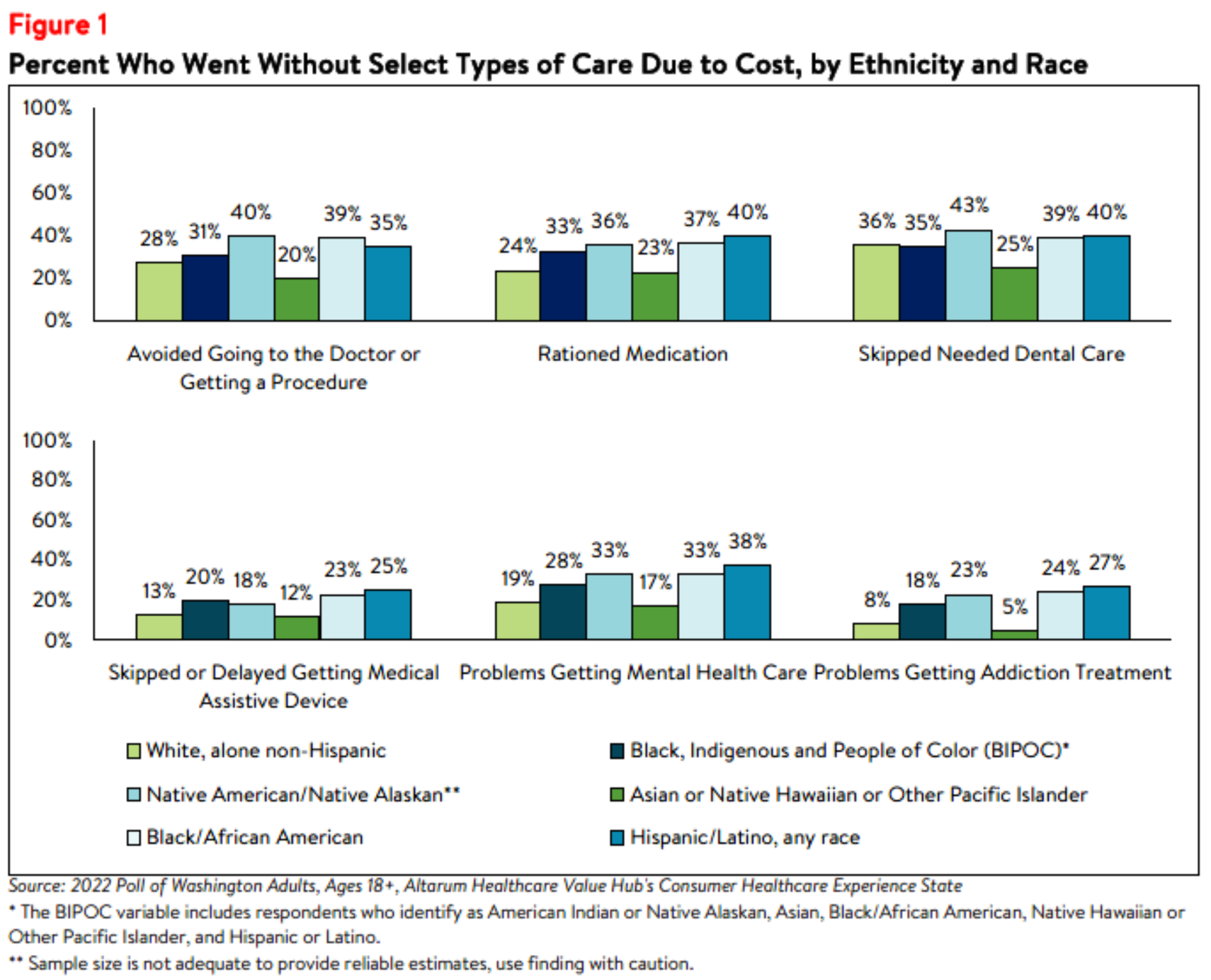
Income
The survey also revealed differences in how Washington respondents experience health care affordability
burdens by income. Unsurprisingly, respondents at the lowest end of the income spectrum most
frequently reported affordability burdens, with more than two-thirds (70%) of those with household
incomes of less than $50,000 per year struggling to afford health care in the past 12 months (see Table
2). Still, over half of respondents living in middle- and high-income households also reported struggling to
afford some aspect of coverage or care, and at least 78% of respondents in each income group reported
worrying about affording health care in the future, demonstrating that affordability burdens impact
people in each income group.
Interestingly, nearly one-third of respondents with incomes less than $50,000 and those earning $75,000
to $99,999 reported not filling a prescription, skipping doses of medicines, or cutting pills due to cost. In
addition, respondents across the income spectrum reported similar rates of financial hardships after
receiving health care services—41% of individuals who earn less than $50,000 a year went into medical
debt, depleted their savings, or sacrificed other basic needs like food, heat or housing due to medical bills,
as did 37% of those earning more than $100,000 per year.

Disability
People with disabilities often interact with the health care system more often than those without
disabilities and, as a result, tend to face more out-of-pocket costs.4 Washington respondents who have or
live with a person who has a disability more frequently reported a diverse array of affordability burdens
compared to those without a disabled household member (see Table 3). In addition, these individuals more frequently reported worrying about losing health insurance specifically (48% versus 22%).
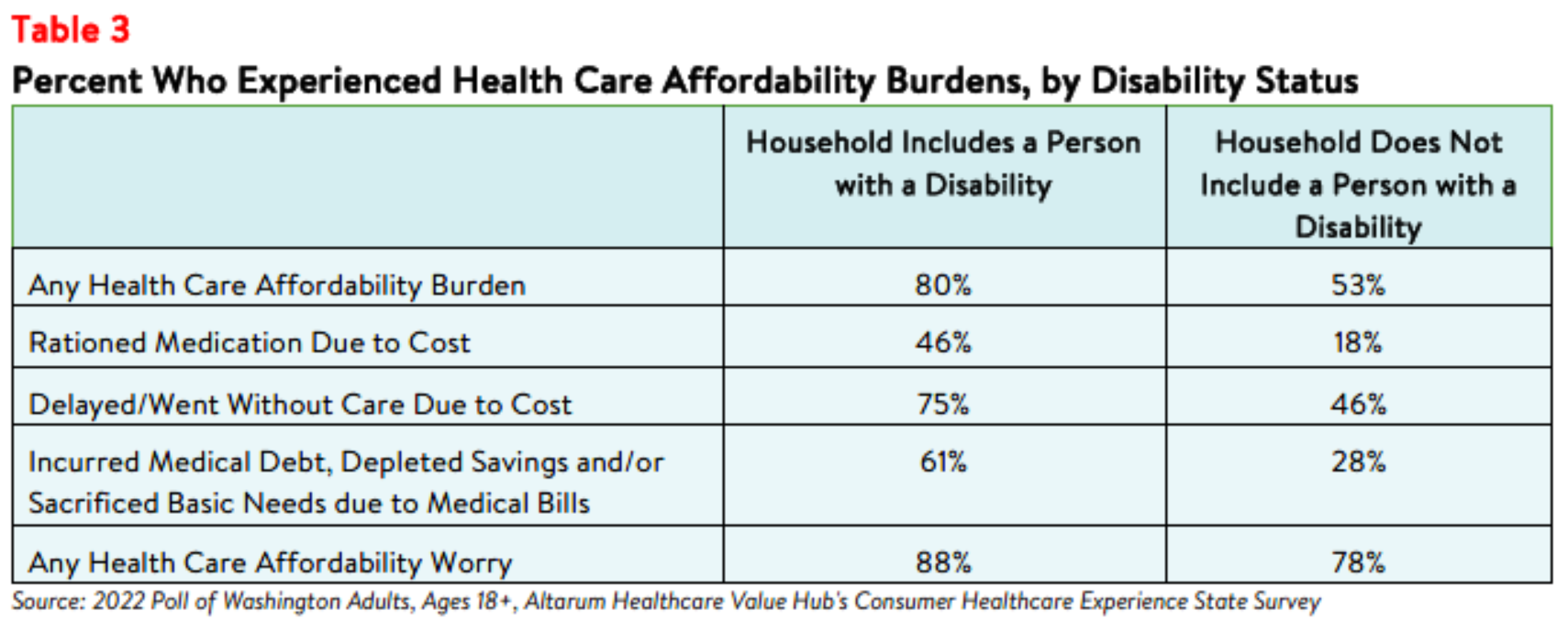
Those with disabilities also face affordability burdens unique to their disabilities—32% of respondents
reporting a disabled person in their household delayed getting a medical assistive device such as a
wheelchair, cane/walker, hearing aid or prosthetic limb due to cost. Just 8% of respondents without a
disability (who may have needed such tools temporarily or may not identify as having a disability) reported
this experience (see Figure 2). Similarly, 39% of respondents with a disability in their household reported
problems getting mental health care compared to 15% of households without a person with a disability.

Gender
The survey also surfaced differences in health care affordability burdens and worry by gender. Women
who responded to the survey more frequently reported experiencing at least one affordability burden in
the past year than men (65% versus 58%) (see Table 4). Women also more frequently reported delaying or going without care due to cost and rationing their medications by not filling a prescription, skipping doses, or cutting pills in half. While many respondents reported being somewhat or very concerned about health care costs regardless of gender, a higher percentage of women reported worrying about affording some aspect of coverage or care than men (85% versus 78%).
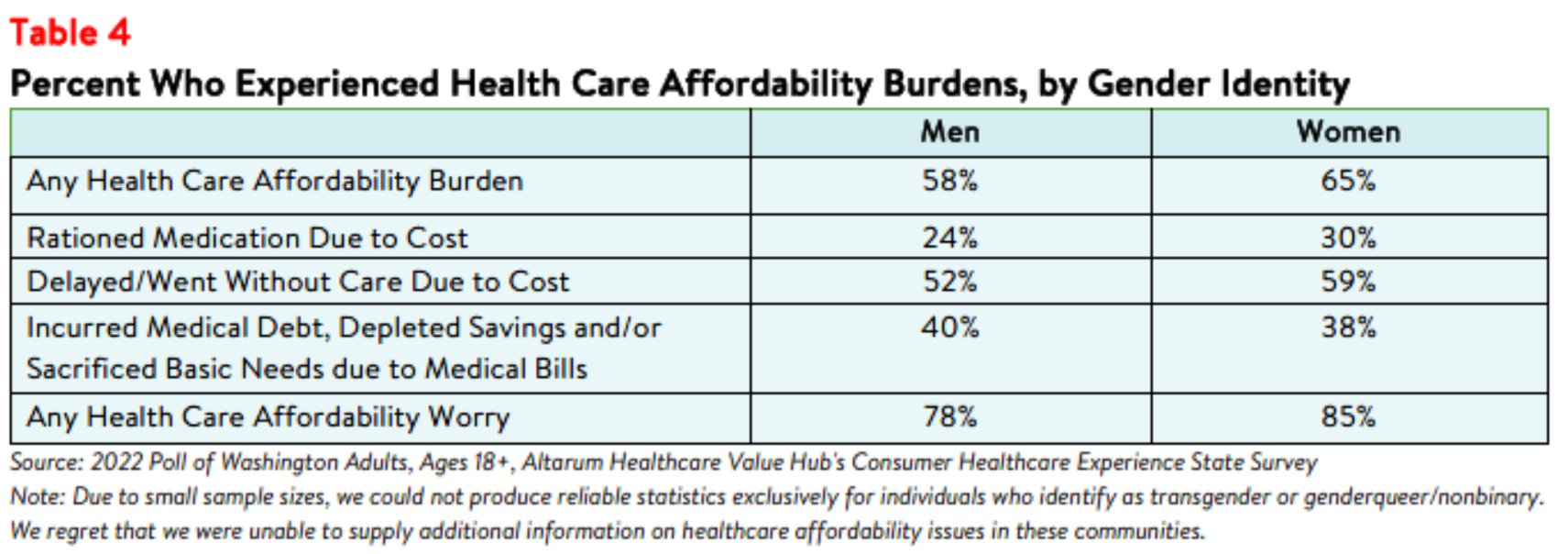
Due to the small sample size, this survey could not produce reliable estimates exclusively for transgender,
genderqueer, or nonbinary respondents. However, it is important to note that these groups experience
unique health care affordability burdens—10 (1% of) survey respondents reported that they or a family
member had trouble affording the cost of gender-affirming care, such as hormone therapy or
reconstructive surgery.
Distrust and Mistrust in the Health System
Whether a patient trusts and/or feels respected by their health care provider may impact whether they
seek needed care. In Washington, just over 1 in 4 (28% of) respondents reported that their provider never,
rarely, or only sometimes treats them with respect. When asked why they felt health care providers did
not treat them with respect, nearly half of those respondents cited their income or financial status (46%),
followed by disability (27%), race (25%) or ethnic background (23%), and gender (24%). In lesser numbers, respondents cited experience with violence or abuse (15%) and sexual orientation (9%) as reasons for the disrespect.
Respondents of color and those with a person with a disability in their household more frequently
reported distrust in and feeling disrespected by their health care providers compared to white and non-
disabled respondents (see Table 5). They also more frequently went without medical care due to that
distrust and/or disrespect. For example, 42% of Hispanic/Latino respondents went without care due to
distrust or disrespect from health care providers compared to 25% of white, non-Hispanic respondents.
Additionally, 47% of respondents who have/are living with a person with a disability went without care due
to distrust or disrespect, compared to 17% of those without a household member with a disability.
Additionally, respondents covered through Washington Medicaid reported higher rates of distrusting or
feeling disrespected by a health care provider and higher rates of going without care due to
distrust/disrespect compared to those with private insurance and Medicare. Respondents earning less
than $50,000 most frequently reported distrust/disrespect as well as going without care due to
distrust/disrespect out of all income groups.
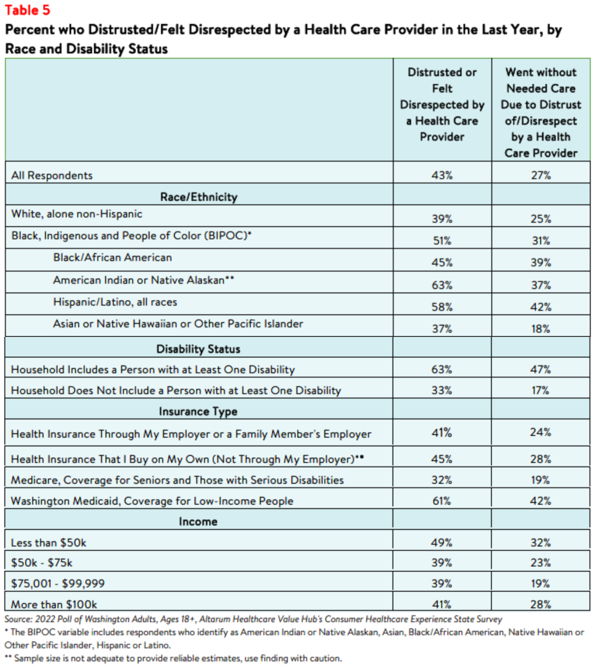
Individual & Systemic Racism
Respondents perceived that both individual and systemic racism exist in the U.S. health care system. Sixty- one percent (61%) of respondents believed that people are treated unfairly based on their race or ethnic background, either somewhat or very often. When asked what they think causes healthcare systems to treat people unfairly based on their race or ethnic background:
- Over 1 in 5 (22%) cited policies and practices built into the health care system;
- Over 1 in 4 (29%) cited the actions and beliefs of individual health care providers; and
- Nearly half (49%) believe it is an equal mixture of both.
Dissatisfaction with the Health System and Support for Change
Given this information, it is not surprising that 73% of respondents agree or strongly agree that the U.S.
health care system needs to change. Understanding how the health care system disproportionately harms
some groups of people over others is key to creating a fairer and higher value system for all.
Making health care affordable for all residents is an area ripe for policymaker intervention, with
widespread support for government-led solutions across party lines. For more information on the types of
strategies Washington residents want their policymakers to pursue, see: Washington Residents Struggle to Afford High Healthcare Costs; Worry About Affording Healthcare in the Future; Support Government Action Across Party Lines, Healthcare Value Hub, Data Brief No. 135 (November 2022).
Notes
-
Fadeyi-Jones, Tomi, et al., High Prescription Drug Prices Perpetuate Systemic Racism. We Can Change It, Patients for Affordable Drugs Now (December 2020),
https://patientsforaffordabledrugsnow.org/2020/12/14/drug-pricing-systemic-racism/ -
Kaplan, Alan and O’Neill, Daniel, “Hospital Price Discrimination Is Deepening Racial Health Inequity,” New England Journal of Medicine—Catalyst (December 2020), https://catalyst.nejm.org/doi/full/10.1056/CAT.20.0593
-
A small share of respondents also reported barriers to care that were unique to their ethnic or cultural backgrounds. Two percent reported not getting needed medical care because they couldn’t find a doctor of the same race, ethnicity or cultural background as them and three percent because they couldn’t find a doctor who spoke their language.
-
Miles, Angel L., Challenges and Opportunities in Quality Affordable Healthcare Coverage for People with Disabilities, Protect Our Care Illinois (February 2021), https://protectourcareil.org/index.php/2021/02/26/challenges-and-opportunities-in-quality-affordable-health-care-coverage-for-people-with-disabilities/
-
A 2019 Commonwealth Fund report noted that people with disabilities risk losing their benefits if they make more than $1,000 per month. According to the Center for American Progress, in most states, people who receive Supplemental Security are automatically eligible for Medicaid. Therefore, if they lose their disability benefits they may also lose their Medicaid coverage. Forbes has also reported on marriage penalties for people with disabilities, including fears about losing health insurance. See: Seervai, Shanoor, Shah, Arnav, and Shah, Tanya, “The Challenges of Living with a Disability in America, and How Serious Illness Can Add to Them,” Commonwealth Fund (April 2019), https://www.commonwealthfund.org/publications/fund-reports/2019/apr/challenges-living-disability-america-and-how-serious-illness-can; Fremstaf, Shawn and Valles, Rebecca, “The Facts on Social Security Disability Insurance and Supplemental Security Income for Workers with Disabilities,” Center for American Progress (May 2013), https://www.americanprogress.org/article/the-facts-on-social-security-disability-insurance-and-supplemental-security-income-for-workers-with-disabilities/; and Pulrang, Andrew, “A Simple Fix For One Of Disabled People’s Most Persistent, Pointless Injustices,” Forbes (April 2020), https://www.forbes.com/sites/andrewpulrang/2020/08/31/a-simple-fix-for-one-of-disabled-peoples-most-persistent-pointless-injustices/?sh=6e159b946b71
Methodology
Altarum’s Consumer Healthcare Experience State Survey (CHESS) is designed to elicit respondents’ unbiased views on a wide range of health system issues, including confidence using the health system, financial burden and possible policy solutions.
This survey, conducted from August 3 to August 16, 2022, used a web panel from online survey company Dynata with a demographically balanced sample of approximately 1,502 respondents who live in Utah. Information about Dynata’s recruitment and compensation methods can be found here. The survey was conducted in English or Spanish and restricted to adults ages 18 and older. Respondents who finished the survey in less than half the median time were excluded from the final sample, leaving 1,347 cases for analysis. After those exclusions, the demographic composition of respondents was as follows, although not all demographic information has complete response rates:
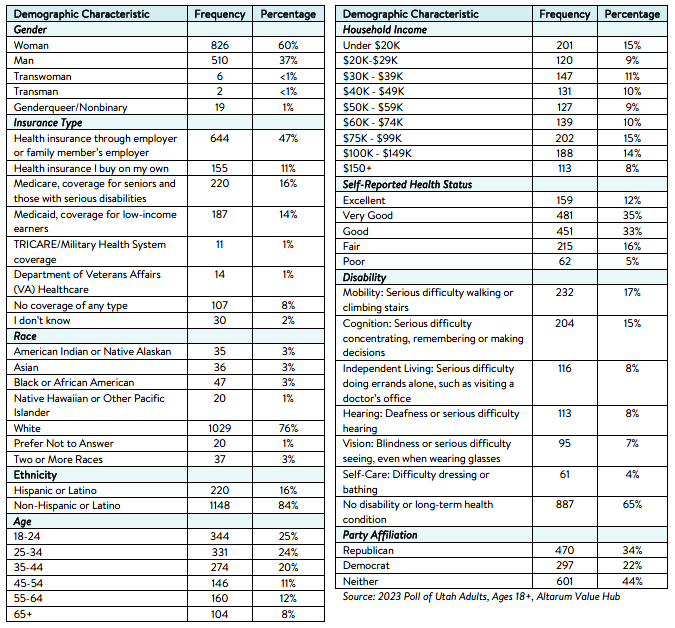
Percentages in the body of the brief are based on weighted values, while the data presented in the demographic table is unweighted. An explanation of weighted versus unweighted variables is available here. Altarum does not conduct statistical calculations on the significance of differences between groups in findings. Therefore, determinations that one group experienced a significantly different affordability burden than another should not be inferred. Rather, comparisons are for conversational purposes. The groups selected for this brief were selected by advocate partners in each state based on organizational/advocacy priorities. We do not report any estimates under N=100 and a co-efficient of variance more than 0.30.







